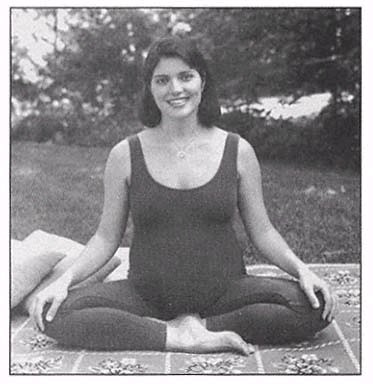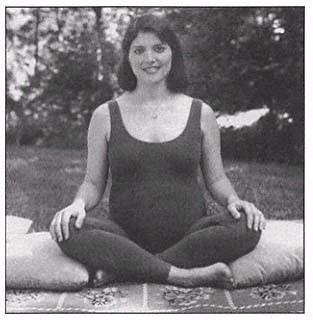Choosing Waterbirth: Reclaiming the Sacred Power of Birth (7 page)
Read Choosing Waterbirth: Reclaiming the Sacred Power of Birth Online
Authors: Lakshmi Bertram,Sandra Amrita McLanahan,Michel Odent

Mentally, the practice of the poses and techniques taught in yoga will create in you a feeling of deep peace. Almost from the very first session, as you move slowly through each pose, you will feel a tranquility settle over you. By the end of the session during the deep relaxation exercise, as your thoughts subside and your worries fade, you will slip easily into a totally
Page 44
relaxed state, reaching a level of relaxation that you may have not felt in years.
Here, in this deeprelaxed state, having been gently exercised, your body will begin repairing anything amiss within your system. If you practice these poses regularly, your body will continue to heal, eventually becoming completely renewed. It is this healing benefit that has made the practice of yoga a central part of the work of both Dr. Dean Ornish and his program for preventing and reversing heart disease, and Dr. Deepak Chopra who, through his books and centers, has been successfully treating many illnesses ranging from stressrelated ulcers to cancer.
During the delicate condition of pregnancy the regular practice of yoga will help keep your health up by supporting the systems of your body that are additionally taxed from this stressful, though natural, condition. As you continue to practice, you will notice that you feel more balanced, more relaxed, not only during the yoga session, but also at other times throughout the day. You will begin to feel an overall sense of calm, a renewed ability to handle the stresses of your life and to meet challenges more readily. Your body will feel strong and healthy, your mind serene.
The following series of yoga poses and stretches are the ones I did during my pregnancies and again, with a few modifications, after the babies were born. Included with the descriptions of these exercises are details of their benefits.
If you have not practiced yoga before, you need to wait until after you have entered your fourth month before you begin the class. Waiting until this time means the greatest risk of miscarriage has passed, and it will allow you to have recovered from most of the nausea and exhaustion that typically accompany the first three months.
There are some exceptions to this rule. The breathing and relaxation techniques may be started at any time. They do not pose any risk to you or the baby and are useful in helping you to feel less tired. Other poses that may be started immediately are noted in the instruction portion of each exercise.
Page 45
If you have been practicing yoga regularly for at least six months prior to becoming pregnant, you can continue to practice under the guidance of a qualified yoga teacher.
If you have any health condition related to or independent of the pregnancy that prohibits your exercising, you should show this prenatal class, described in the next chapter, to your practitioner and get approval prior to beginning the class.
Page 46
Chapter 11—
How to Begin
Yoga should be done regularly, at least two to three times a week, and is ideally done daily, to reap the most benefit. If you find yourself short of time, or are too tired to do a complete class, at least do the relaxation exercise, as this is the single most important technique you can practice to help you have a more comfortable pregnancy, a more positive birth experience, and an easier recovery period once the baby is born.
Contrary to traditional yoga practices which recommend you abstain from food or drink before you practice, for prenatal yoga it is recommended that you eat a small snack within thirty to fortyfive minutes of beginning. This will keep you from feeling dizzy or nauseous from exercising on an empty stomach while pregnant. If at any time you do feel dizzy or nauseous, stop the class and lie down on your left side, to allow for the optimal blood flow to the baby, and take a few slow, deep breaths to relax. Remember that your body will not be as reliable as usual during your pregnancy. One day you may sail through the entire class feeling energetic and vibrant, while the next day even the slightest movement will make you feel exhausted. Always listen to your body and do what it tells you. Not only will this prevent you from overdoing it while you are pregnant, but it will also develop this selfawareness into a habit which will come in useful during your birthing.
Your practice surface should be soft, preferably carpeted. A mat or blanket may be laid over a bare floor if you do not have Page 47
carpeting, but care must be taken to make sure you do not slip during the standing poses and the ones done by the wall. For the class, you will need three or four pillows that will be used at various times. Set them beside your practice area at the beginning of the class so you will have them at hand when you need them.
Once you are ready to start, begin slowly. As you practice regularly you will be able to increase the duration of the poses and the number of times each pose repeats.
But in the beginning err on the side of caution and always stop at about half the maximum that you feel you can do. Yoga is not like other exercises in that you prove their worth by how well you can do them. The benefit of yoga comes from the manner in which each pose is done, as well as from the pose itself. This is why the simplest beginner can reap much the same benefit as the advanced practitioner.
During the class always remain aware of your body. Never strain or overstretch during the class. Pay close attention to how each movement feels. As you move through the poses notice which parts of your body feel strong and which feel weak, which are tight and which are flexible. Becoming aware of how your body feels during each pose allows you to begin modifying your body, making the weak parts stronger, and the tight parts more flexible, and allowing you to achieve an overall sense of balance throughout your physique.
This awareness of your body is a fringe benefit of practicing yoga. By being aware during pregnancy you recognize the many changes that are taking place, and are able to adapt to them more readily. Being aware of your body also means being aware of your baby, giving you the daily opportunity to consciously focus on your baby growing inside you.

Page 48
Chapter 12—
Prenatal Yoga Class
Begin by taking a comfortable seated position. As your pregnancy progresses, you may find that sitting in a chair is no longer comfortable as your legs can swell from hanging over the sides of your chair. Learning a few comfortable positions for sitting on the floor will give you an alternative to chair sitting.
On the floor, sit with your legs crossed. If this is not comfortable, place a pillow under your buttocks to elevate your hips. A pillow placed here can help you to sit up straighter and it removes some of the strain from your hip joints. You may also place a pillow under each leg, to support your knees.
Adjust your position until you feel the most comfortable. Close your eyes and sit up straight, feeling as if you are lifting


Page 49
from the center of your head all the way along your spine toward the ceiling. Inhale slowly and deeply and exhale in the same relaxed manner. Do this three times, feeling as though you are letting go, releasing all of your tension with each exhalation and bringing focus and awareness in with each inhalation.
Neck stretches:
Still seated, inhale; as you exhale, slowly drop your chin to your chest. Hold this position for a moment, breathing normally. Then, on an inhalation, raise your head back to center. On your next exhalation, bend your head to the right, right ear toward right shoulder, hold, inhale, and raise to center. Exhale, left ear toward left shoulder, inhale, and raise to center. Repeat this sequence two more times, focusing on gently stretching and feeling the release of tension in this area; stop when you raise your head to the center again.
Neck rolls:
Inhale, exhale, bring your chin to your chest to center, hold; as you inhale this time, roll your head to the side until your right ear is over your right shoulder; exhale, roll back to center; inhale, roll to the left. Finish by raising your head to center. Repeat three times each way.
Generally, if you find that you carry a lot of tension in

Page 50
your neck, build up to doing eight to ten repetitions for this exercise and repeat throughout out the day. Don't push it, as you could give yourself a headache or a sore neck.
BENEFITS: Neck stretches and rolls are good for releasing tension in the back of your neck, something you are likely to experience a lot as your girth increases. The muscles in the back of your neck attach to the muscles that expand around your abdomen, so as your stomach gets bigger, those muscles pull on your neck muscles and cause them to get tighter. Regularly stretching your neck muscles can prevent the accompanying tension and strain that can result.
Shoulder rolls:
Raise your hands so your fingertips rest lightly on your shoulders. Have your elbows lead the movement, bringing them forward, up, back, and down, making a complete circle. Focus on moving slowly and fully through the movement. Do three repetitions, then reverse the process, rolling forward.
BENEFITS: This exercise relaxes and strengthens the muscles of the shoulders and upper back. They also help to maintain good posture. Your arms will be used for everything once the baby is born and you are likely to develop what I call ''nurser's syndrome." This refers to the tightness in your arms, neck, and shoulders, and the accompanying aching and cramping that come from carrying the baby all the time, bending over the baby all the time, and looking at the baby all the
